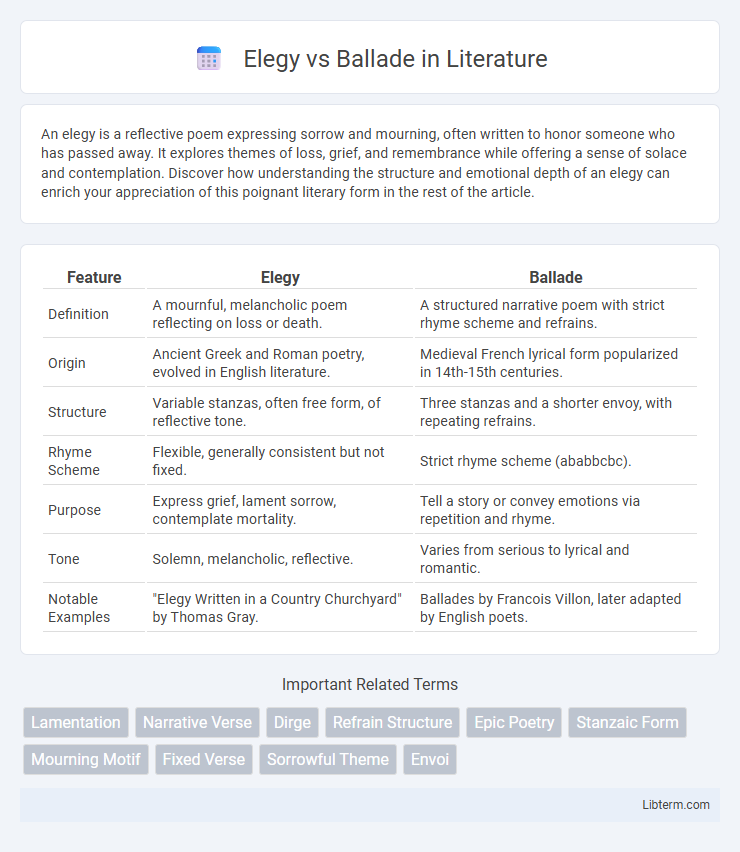An elegy is a reflective poem expressing sorrow and mourning, often written to honor someone who has passed away. It explores themes of loss, grief, and remembrance while offering a sense of solace and contemplation. Discover how understanding the structure and emotional depth of an elegy can enrich your appreciation of this poignant literary form in the rest of the article.
Table of Comparison
| Feature | Elegy | Ballade |
|---|---|---|
| Definition | A mournful, melancholic poem reflecting on loss or death. | A structured narrative poem with strict rhyme scheme and refrains. |
| Origin | Ancient Greek and Roman poetry, evolved in English literature. | Medieval French lyrical form popularized in 14th-15th centuries. |
| Structure | Variable stanzas, often free form, of reflective tone. | Three stanzas and a shorter envoy, with repeating refrains. |
| Rhyme Scheme | Flexible, generally consistent but not fixed. | Strict rhyme scheme (ababbcbc). |
| Purpose | Express grief, lament sorrow, contemplate mortality. | Tell a story or convey emotions via repetition and rhyme. |
| Tone | Solemn, melancholic, reflective. | Varies from serious to lyrical and romantic. |
| Notable Examples | "Elegy Written in a Country Churchyard" by Thomas Gray. | Ballades by Francois Villon, later adapted by English poets. |
Understanding Elegy: Definition and Origins
An elegy is a poetic form rooted in ancient Greek and Roman traditions, characterized by its mournful tone and themes of loss or mourning. Typically written in a reflective and melancholic style, an elegy explores grief, often commemorating the dead and expressing sorrow or lamentation. Its origins trace back to classical poetry, where it structured expressions of personal and collective mourning, setting it apart from lighter or narrative forms like the ballade.
Exploring Ballade: Definition and Historical Roots
The ballade is a medieval French poetic form consisting of three main stanzas with a recurring refrain, typically used to convey themes of chivalry, love, and morality. Originating in the 13th and 14th centuries, the ballade gained prominence through the works of poets like Guillaume de Machaut and Christine de Pizan, reflecting the cultural and literary trends of the Middle Ages. This form's structured rhyme scheme and refrain distinguish it from the elegy, which is more flexible and centered on mourning and reflection.
Structural Differences: Elegy vs Ballade
Elegies are typically composed in a free verse or irregular stanza form, emphasizing reflective and mournful tones without strict structural constraints. Ballades follow a fixed verse pattern with three main stanzas and a shorter envoi, employing a consistent rhyme scheme (usually ababbcbC) and refrains that enhance musicality and repetition. The structural rigidity of ballades contrasts with the elegy's flexible format, which accommodates emotional expression and thematic exploration.
Thematic Contrasts Between Elegy and Ballade
Elegies focus on themes of mourning, loss, and reflection, often expressing sorrow for the deceased or a somber meditation on mortality. Ballades typically emphasize narrative storytelling, combining themes of chivalry, love, and moral lessons within a structured rhyme scheme. The thematic contrast between elegy and ballade lies in elegy's introspective sorrow versus ballade's outward, often lively, narrative engagement.
Poetic Devices Used in Elegies
Elegies frequently employ repetition, alliteration, and metaphor to evoke deep emotions and reflect on loss and mourning, enhancing the poem's somber tone. The use of elegiac couplets and a melancholic rhythm often underscores themes of grief and remembrance. Imagery and personification are also prominent, allowing the elegy to convey sorrow and memorialize the deceased with vivid, emotional language.
Rhyme Scheme and Form in Ballades
Ballades follow a strict rhyme scheme, typically ABABBCBC, often with three stanzas and a shorter concluding envoi, while elegies do not adhere to a fixed rhyme pattern, focusing instead on mournful or reflective content. The ballade's formal structure and repeated refrain distinguish it as a lyrical poem rooted in medieval French poetry, emphasizing musicality and repetition. Elegies prioritize emotional expression over structural constraints, making them more flexible in form and rhyme usage.
Emotional Tone: Elegiac Melancholy vs Ballade Formality
Elegies convey a poignant elegiac melancholy, expressing deep sorrow and reflective mourning through their somber emotional tone and introspective language. Ballades maintain a formal emotional tone, often structured with strict rhyme schemes and refrains, evoking a sense of order and lyrical dignity. The contrasting emotional atmospheres highlight elegies' personal grief against ballades' stylized, dignified expression.
Famous Elegies and Renowned Ballades
Famous elegies such as Thomas Gray's "Elegy Written in a Country Churchyard" and W.H. Auden's "In Memory of W.B. Yeats" poignantly express themes of mourning and reflection on mortality. Renowned ballades like Francois Villon's "Ballade des dames du temps jadis" and Claude Debussy's musical ballades offer structured verses with a refrain, often narrating heroic or romantic tales. Both forms have rich literary and musical traditions that highlight human emotion through distinct rhythmic and thematic approaches.
Influence of Elegy and Ballade in Modern Poetry
Elegy and ballade have profoundly shaped modern poetry by providing distinct frameworks for expressing emotion and narrative. The elegy's melancholic reflection on loss influences contemporary themes of grief and introspection, while the ballade's structured form inspires innovations in rhythm and rhyme schemes. Poets adapt these traditional genres to explore modern identity and cultural memory, demonstrating their enduring relevance in today's literary landscape.
Choosing Between Elegy and Ballade in Creative Writing
Choosing between an elegy and a ballade in creative writing depends on the emotional tone and structure desired; elegies express mourning and reflection using free verse or irregular rhyme, while ballades follow a strict three-stanza form with a refrain, often narrating heroic or romantic tales. Writers seeking to convey deep grief or commemorate loss might opt for elegies to emphasize solemnity and personal tribute. Those aiming for rhythmic storytelling with a memorable refrain often prefer ballades to create lyrical patterns and thematic resonance.
Elegy Infographic

 libterm.com
libterm.com